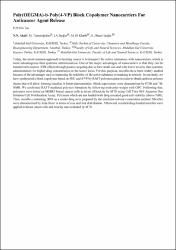| dc.contributor.author | Aksit, N. N. | |
| dc.contributor.author | Topuzogullari, M. | |
| dc.contributor.author | Isoglu, I. A. | |
| dc.contributor.author | El Khatib, M. | |
| dc.contributor.author | Isoglu, S. Dincer | |
| dc.date.accessioned | 2019-07-01T10:42:37Z | |
| dc.date.available | 2019-07-01T10:42:37Z | |
| dc.date.issued | 2018 | en_US |
| dc.identifier.citation | FEBS OPEN BIO Volume: 8 Pages: 476-476 Supplement: 1 Meeting Abstract: P.25-014-T | en_US |
| dc.identifier.issn | 2211-5463 | |
| dc.identifier.other | Accession Number: WOS:000437674105210 | |
| dc.identifier.uri | http://acikerisim.agu.edu.tr/xmlui/handle/20.500.12573/58 | |
| dc.description | Document Type: Meeting Abstract | en_US |
| dc.description.abstract | Today, the most common approach to treating cancer is to transport the active substances with nanocarriers, which is more advantageous than systemic administration. One of the major advantages of nanocarriers is that they can be transferred to tumors (EPR effect) through passive targeting due to their small size and with lower toxicity than systemic administration for higher drug concentration in the tumor locus. For this purpose, micelles have been widely studied because of the advantages such as increasing the solubility of the active substance or masking its toxicity. In our study, we have synthesized a block copolymer based on PEG and 4VP by RAFT polymerization in order to obtain uniform polymer chains that will allow forming micelles in better characteristics. Block copolymers were characterized by FTIR and 1H NMR. We confirmed RAFTmediated polymer formation by following molecular weight with GPC. Following that, polymers were tested on SKBR3 breast cancer cells in terms of toxicity by MTS using Cell Titer 96® Aqueous One Solution Cell Proliferation Assay. Polymers which are not loaded with drug revealed good cell viability (above %80). Then, micelles containing DOX as a model drug were prepared by the emulsionsolvent evaporation method. Micelles were characterized by Zeta Sizer in terms of size and size distribution. Afterward, resulted drugloaded micelles were applied to breast cancer cells and toxicity was evaluated by MTS. | en_US |
| dc.language.iso | eng | en_US |
| dc.publisher | WILEY, 111 RIVER ST, HOBOKEN 07030-5774, NJ USA | en_US |
| dc.relation.ispartofseries | FEBS OPEN BIO;Volume: 8 Pages: 476-476 Supplement: 1 Meeting Abstract: P.25-014-T | |
| dc.rights | info:eu-repo/semantics/openAccess | en_US |
| dc.title | Poly(OEGMA)-b-Poly(4-VP) block copolymer nanocarriers for anticancer agent release | en_US |
| dc.type | conferenceObject | en_US |
| dc.contributor.department | AGÜ, Yaşam ve Doğa Bilimleri Fakültesi, Biyomühendislik Bölümü | en_US |
| dc.contributor.institutionauthor | | |
| dc.relation.publicationcategory | Konferans Öğesi - Uluslararası - Kurum Öğretim Elemanı | en_US |


















